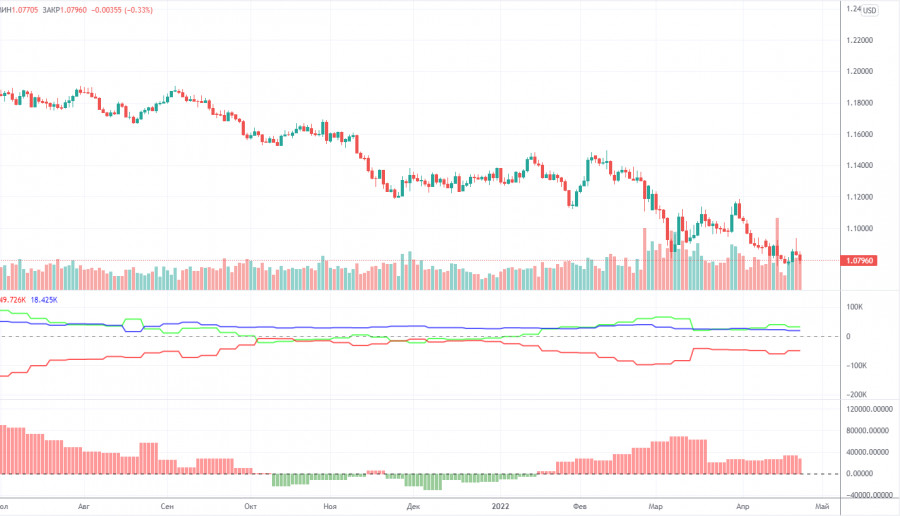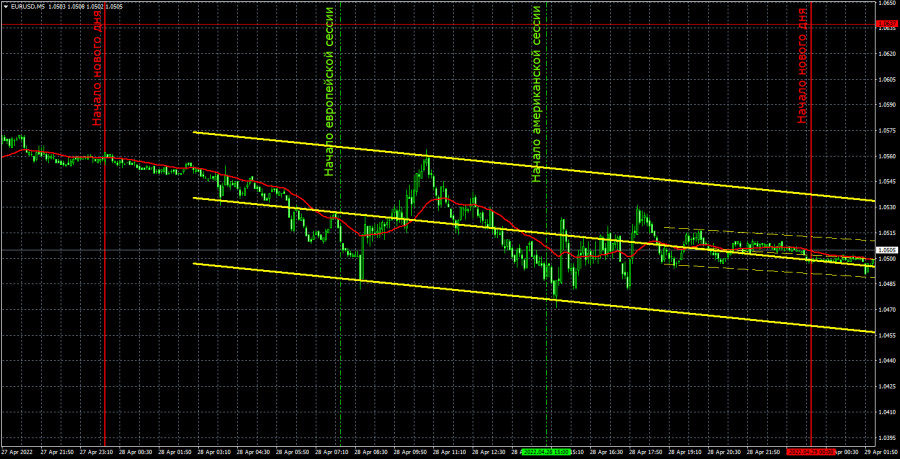EUR/USD 5M
The EUR/USD pair continued to fall on Thursday. This time it did not drop as much. At the end of the day, the volatility was about 100 points, but the euro lost only 60. In fact, this is quite a lot, but not as much as in the previous few days. The most important thing is that the euro continues to fall against the dollar. There have already been several attempts to start an upward correction, however, by the end of the day, the pair still fell. Also, an important report on US GDP in the first quarter was published on Thursday, which turned out to be significantly worse than forecasts. But guess if the dollar fell after this report? That's right, no! So now we can even conclude that macroeconomics is absolutely unimportant for the market. One is ready to sell the euro at any macroeconomic data. And there are no new geopolitical and fundamental events that have a better chance of influencing what is happening now.
No trading signals were generated on Thursday. We have already said that the pair has not traded at current price values for a very long time, so there are simply no levels near which signals could be formed. The price must stay in this area for some time for the levels to form. Then it will be possible to trade on them.
COT report:

The latest Commitment of Traders (COT) reports on the euro raised more questions than they provided answers! Major players, starting from January 2022, maintain a bullish mood. And the euro, starting from January 2022, maintains a downward trend. During the reporting week, the number of long positions decreased by 600, and the number of shorts from the "non-commercial" group increased by 7,000. Thus, the net position decreased by 6,000 contracts. This means that the bullish mood has weakened a bit. However, it still remains bullish, since the number of long positions now exceeds the number of short positions with non-commercial traders by 32,000. Accordingly, the paradox lies in the fact that professional players generally buy euros more than they sell, but the euro continues to fall almost non-stop, which is clearly seen in the chart above. We have already explained earlier that this effect is achieved by a higher demand for the US dollar. The demand for the dollar is higher than the demand for the euro, which is why the dollar is rising against the euro. There is such an effect "due" to the geopolitical conflict in Ukraine. Therefore, the data of COT reports on the euro now do not give an opportunity to predict the further movement of the pair. The longer the phase of active hostilities in Ukraine persists, the higher the probability of a collision between the European Union and the food and energy crisis, and the dollar will continue to grow due to its status as a "reserve" currency.
We recommend to familiarize yourself with:
Overview of the EUR/USD pair. April 29. The energy crisis can drive a tank through the European economy. But it is inevitable.
Overview of the GBP/USD pair. April 29. Scholz's ban on the supply of weapons to Ukraine does not suit the Germans. Lend-Lease, rearmament of the Armed Forces of Ukraine.
Forecast and trading signals for GBP/USD on April 29. Detailed analysis of the movement of the pair and trading transactions.
EUR/USD 1H

You can see on the hourly timeframe that the pair continues a strong downward movement. And most importantly – recoilless. Theoretically, the euro can continue to fall as long as you like, but every day there are more and more questions about this movement. Whatever the fundamental and geopolitical backgrounds, at this rate the pair will reach price parity in a couple of weeks. We believe that this is still too strong a fall in the euro and it is unreasonable. After its completion, a strong and powerful upward movement may follow. We allocate the following levels for trading on Friday – 1.0340-1.0369, 1.0637, 1.0729, 1.0761, 1.0806, as well as the Senkou Span B (1.0816) and Kijun-sen (1.0658) lines. The lines of the Ichimoku indicator can move during the day, which should be taken into account when determining trading signals. There are also secondary support and resistance levels, but no signals are formed near them. Signals can be "bounces" and "breakthrough" levels - extremes and lines. Do not forget about placing a Stop Loss order at breakeven if the price went in the right direction of 15 points. This will protect you against possible losses if the signal turns out to be false. The European Union will publish data on inflation and GDP on April 29. We believe that these are very important reports, and their values may come as a surprise to traders. Nevertheless, if the market reaction is the same as yesterday, then there will be little sense from these reports. If they turn out to be significantly worse than forecasts, then even more so – the euro is falling every day and without bad statistics.
Explanations for the chart:
Support and Resistance Levels are the levels that serve as targets when buying or selling the pair. You can place Take Profit near these levels.
Kijun-sen and Senkou Span B lines are lines of the Ichimoku indicator transferred to the hourly timeframe from the 4-hour one.
Support and resistance areas are areas from which the price has repeatedly rebounded off.
Yellow lines are trend lines, trend channels and any other technical patterns.
Indicator 1 on the COT charts is the size of the net position of each category of traders.
Indicator 2 on the COT charts is the size of the net position for the non-commercial group.














